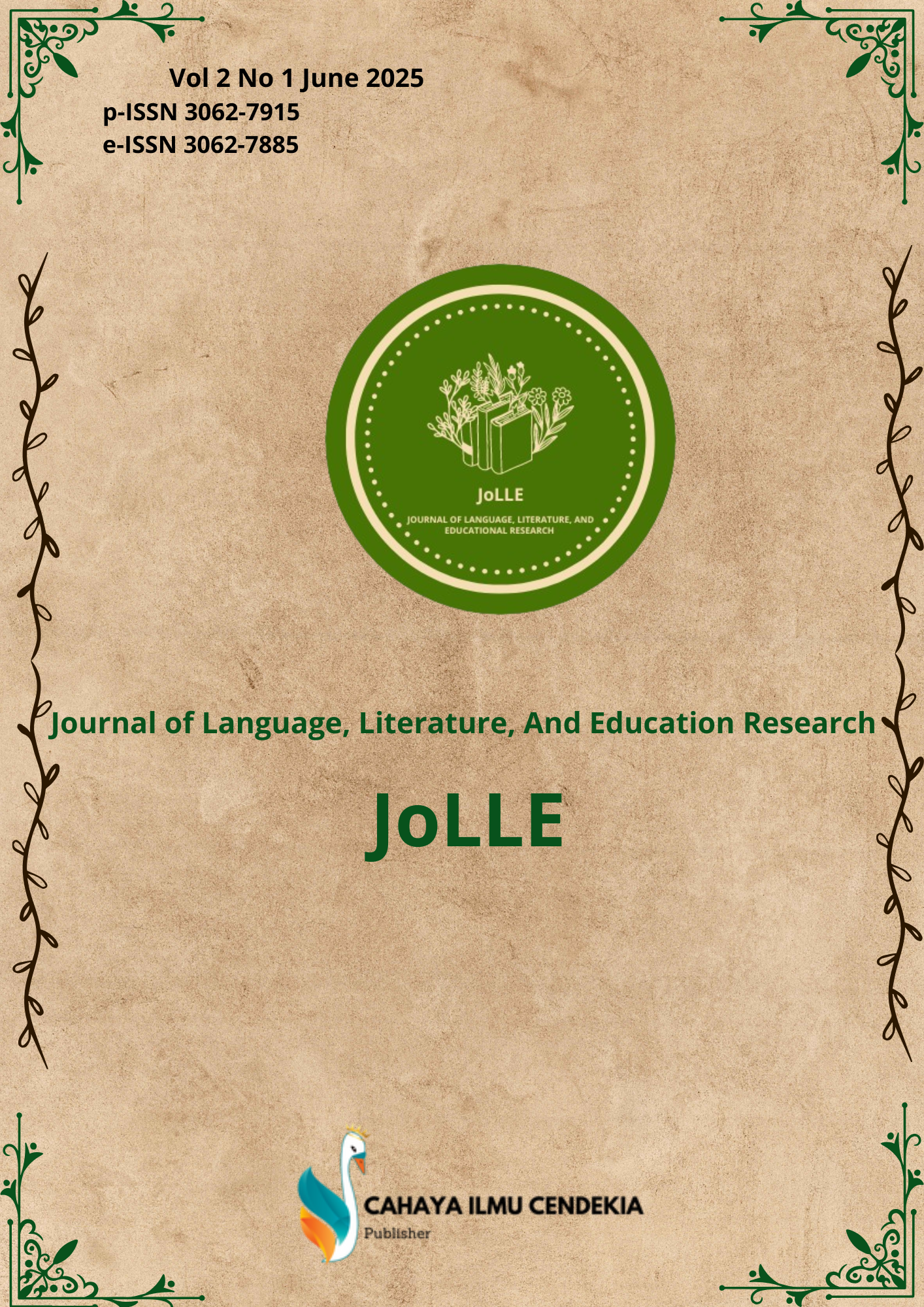Investigating Anecdotal Text Writing Ability In Tenth Grade Learners
Abstract
Purpose of the study: This study aims to describe the ability of class X students at MAN 01 Kota Bengkulu in writing anecdotal texts, particularly focusing on the structure and linguistic features of the text.
Methodology: This study used a descriptive method with a quantitative approach. The population included all 317 tenth-grade students of MAN 01 Kota Bengkulu in the 2022/2023 academic year. The sample of 23 students was selected using purposive sampling. Data were collected through a writing test with a rubric assessing five structural components of anecdotal texts and linguistic features. The average score formula was used for data analysis.
Main Findings: The findings show that students’ ability to write anecdotal texts is generally categorized as good with an average score of 76.71. Specifically, the abstraction aspect was excellent (12.3), orientation good (14.9), crisis good (14.4), reaction excellent (12.4), coda excellent (11.4), and linguistic elements excellent (11.4). These results indicate that most students have mastered the structure and language use of anecdotal texts effectively.
Novelty/Originality of this study: This study provides a focused evaluation of students’ writing based on the complete five-part structure of anecdotal texts combined with linguistic criteria. Unlike prior studies, this research offers a comprehensive assessment using a targeted rubric and highlights specific strengths and weaknesses across each structural and linguistic component, contributing to curriculum-based evaluation methods in writing instruction.
References
M. Alangari, S. Jaworska, and J. Laws, “Who’s afraid of phrasal verbs? The use of phrasal verbs in expert academic writing in the discipline of linguistics,” J. English Acad. Purp., vol. 43, p. 100814, 2020, doi: 10.1016/j.jeap.2019.100814.
P. E. Jones and C. Read, “Mythbusters united? A dialogue over Harris’s integrationist linguistics and Gibson’s Ecological Psychology,” Lang. Sci., vol. 97, p. 101536, 2023, doi: 10.1016/j.langsci.2023.101536.
T. T. Voorhees and O. Vorobel, “Integrating qualitative research into the community college linguistics course: An autoethnographic inquiry,” Int. J. Educ. Res. Open, vol. 2, no. June, p. 100053, 2021, doi: 10.1016/j.ijedro.2021.100053.
K. U. Isisag, “The efficacy of macro-linguistics in developing reading skills: An integrated lesson plan,” Procedia - Soc. Behav. Sci., vol. 9, pp. 698–703, 2010, doi: 10.1016/j.sbspro.2010.12.220.
E. Leivada and E. Murphy, “Mind the (terminological) gap: 10 misused, ambiguous, or polysemous terms in linguistics,” Ampersand, vol. 8, p. 100073, 2021, doi: 10.1016/j.amper.2021.100073.
C. G. Quan, “Continuing with the promise of ‘Scratch’ in the applied linguistics classroom,” Procedia - Soc. Behav. Sci., vol. 103, pp. 245–254, 2013, doi: 10.1016/j.sbspro.2013.10.332.
M. A. Candel-Mora and C. Vargas-Sierra, “An analysis of research production in corpus linguistics applied to translation,” Procedia - Soc. Behav. Sci., vol. 95, pp. 317–324, 2013, doi: 10.1016/j.sbspro.2013.10.653.
R. Z. Abid and S. A. Manan, Integrating corpus linguistics in critical literacy pedagogy: A case study of lance armstrong’s transformation from a titleholder to a fraud, vol. 208, no. Icllic 2014. Elsevier B.V., 2015. doi: 10.1016/j.sbspro.2015.11.189.
H. Jalali, “Reflection of stance through it bundles in applied linguistics,” Ampersand, vol. 4, pp. 30–39, 2017, doi: 10.1016/j.amper.2017.06.001.
M. Pikhart, “New horizons of intercultural communication: Applied linguistics approach,” Procedia - Soc. Behav. Sci., vol. 152, pp. 954–957, 2014, doi: 10.1016/j.sbspro.2014.09.349.
H. Bromhead, “Disaster linguistics, climate change semantics and public discourse studies: a semantically-enhanced discourse study of 2011 Queensland Floods,” Lang. Sci., vol. 85, p. 101381, 2021, doi: 10.1016/j.langsci.2021.101381.
A. M. Fazilatfar and Z. S. Naseri, “Rhetorical moves in applied linguistics articles and their corresponding iranian writer identity,” Procedia - Soc. Behav. Sci., vol. 98, pp. 489–498, 2014, doi: 10.1016/j.sbspro.2014.03.444.
T. Popescu, “Developing english linguistics students’ translation competence through the language learning process,” Procedia - Soc. Behav. Sci., vol. 93, pp. 1075–1079, 2013, doi: 10.1016/j.sbspro.2013.09.333.
Z. E. Attia, A. M. Gadallah, and H. M. Hefny, “An enhanced multi-view fuzzy information retrieval model based on linguistics,” IERI Procedia, vol. 7, pp. 90–95, 2014, doi: 10.1016/j.ieri.2014.08.015.
Z. Seifoori and J. Fattahi, “The comparison of the method section of applied linguistics articles written by native and iranian writers in terms of grammatical complexity and clause types,” Procedia - Soc. Behav. Sci., vol. 98, pp. 1698–1705, 2014, doi: 10.1016/j.sbspro.2014.03.596.
J. M.-H. Lim, J. M. Storey, S.-L. Chang, M. S. Esa, and S. A. Damit, “Preface: Multiple roles of language and linguistics in society,” Procedia - Soc. Behav. Sci., vol. 134, no. Iclalis 2013, pp. 1–2, 2014, doi: 10.1016/j.sbspro.2014.04.217.
L. Wang, “Designing and implementing outcome-based learning in a linguistics course: A case study in Hong Kong,” Procedia - Soc. Behav. Sci., vol. 12, pp. 9–18, 2011, doi: 10.1016/j.sbspro.2011.02.004.
A. V. Tsepilova and L. V. Mikhaleva, “Working with formulaic language as a way to evaluate and improve EFL non-linguistics students’ pragmatic skills in a culture-specific contextual situation,” Procedia - Soc. Behav. Sci., vol. 200, no. October, pp. 550–556, 2015, doi: 10.1016/j.sbspro.2015.08.022.
Y. Wang and J. Soler, “Investigating predatory publishing in political science: a corpus linguistics approach,” Appl. Corpus Linguist., vol. 1, no. 1, p. 100001, 2021, doi: 10.1016/j.acorp.2021.100001.
S. Pesina and T. Solonchak, “Concept in cognitive linguistics and biocognitive science,” Procedia - Soc. Behav. Sci., vol. 192, no. 3519, pp. 587–592, 2015, doi: 10.1016/j.sbspro.2015.06.100.
T. A. Shiryaeva, A. A. Arakelova, E. V. Tikhonova, and N. M. Mekeko, “Anti-, Non-, and Dis-: the linguistics of negative meanings about youtube,” Heliyon, vol. 6, no. 12, 2020, doi: 10.1016/j.heliyon.2020.e05763.
N. V. Semenova and A. N. Sitsyna-Kudryavtseva, “About the term ‘dependent taxis’ in modern linguistics,” Procedia - Soc. Behav. Sci., vol. 200, no. October, pp. 149–156, 2015, doi: 10.1016/j.sbspro.2015.08.036.
M. Brooke, “‘Feminist’ in the sociology of sport: An analysis using legitimation code theory and corpus linguistics,” Ampersand, vol. 7, p. 100068, 2020, doi: 10.1016/j.amper.2020.100068.
M. Pikhart, “Human-computer interaction in foreign language learning applications: Applied linguistics viewpoint of mobile learning,” Procedia Comput. Sci., vol. 184, pp. 92–98, 2021, doi: 10.1016/j.procs.2021.03.123.
H. Van Pham, P. Moore, and B. Cong Cuong, “Applied picture fuzzy sets with knowledge reasoning and linguistics in clinical decision support system,” Neurosci. Informatics, vol. 2, no. 4, p. 100109, 2022, doi: 10.1016/j.neuri.2022.100109.
A. Schilling et al., “Analysis of continuous neuronal activity evoked by natural speech with computational corpus linguistics methods,” Lang. Cogn. Neurosci., vol. 36, no. 2, pp. 167–186, 2021, doi: 10.1080/23273798.2020.1803375.
S. Rezaei, D. Kuhi, and M. Saeidi, “Diachronic corpus analysis of stance markers in research articles: The field of applied linguistics,” Cogent Arts Humanit., vol. 8, no. 1, 2021, doi: 10.1080/23311983.2021.1872165.
D. Khairiah, S. Fatinah, J. Endardi, Nursyamsi, and D. Atmawati, “Genetic relationship between Kaili and Pamona languages: a historical comparative linguistics study,” Cogent Arts Humanit., vol. 11, no. 1, p., 2024, doi: 10.1080/23311983.2024.2409517.
M. Diko, “Harmonizing Africa’s linguistic symphony: navigating the complexities of translating African literature using a postcolonial theory,” Cogent Arts Humanit., vol. 11, no. 1, p., 2024, doi: 10.1080/23311983.2024.2411871.
R. Nhongo and L. Siziba, “Intellectualising African languages in literature and linguistics at selected Zimbabwean higher learning institutions,” South African J. African Lang., vol. 44, no. 3, pp. 223–230, 2024, doi: 10.1080/02572117.2024.2385262.
R. Iye, I. W. Simpen, I. N. Sedeng, I. M. Netra, I. M. Said, and F. I. N. Abida, “Language contextualization in public space in Maluku Province: A landscape linguistics study,” Cogent Arts Humanit., vol. 10, no. 1, 2023, doi: 10.1080/23311983.2023.2247648.
I. Mukahal and M. M. Idrus, “Negation forms in the poetry of philip larkin,” Comp. Lit. East West, vol. 8, no. 2, pp. 207–220, 2024, doi: 10.1080/25723618.2024.2395216.
L. Fontaine, “On prepositions and particles: A case for lexical representation in systemic functional linguistics,” Word, vol. 63, no. 2, pp. 115–135, 2017, doi: 10.1080/00437956.2017.1309029.
Hendrokumoro, F. Darman, N. Nuraeni, and N. K. Ma’shumah, “The genetic relationship between alune, lisabata, luhu, and wemale (western seram, Indonesia): A historical-comparative linguistics approach,” Cogent Arts Humanit., vol. 11, no. 1, p., 2024, doi: 10.1080/23311983.2024.2306718.
D. A. S. El-Dakhs, L. Mardini, and L. Alhabbad, “The persuasive strategies in more and less prestigious linguistics journals: focus on research article abstracts,” Cogent Arts Humanit., vol. 11, no. 1, p., 2024, doi: 10.1080/23311983.2024.2325760.
L. Zhao and P. Issra, “Traditional Chinese Medicine (TCM) research articles unpacked: a systemic functional linguistics (SFL) elemental genre approach,” Cogent Arts Humanit., vol. 11, no. 1, p., 2024, doi: 10.1080/23311983.2024.2317617.
R. Alshalan and H. S. Alyousef, “Enhancing English–Arabic translator education through systemic functional linguistics: a study in a Saudi undergraduate classroom,” Saudi J. Lang. Stud., 2025, doi: 10.1108/sjls-09-2024-0054.
A. Q. Al Darwesh, “The representation of authorial and external voice in popular science book writing: a systemic functional linguistics approach,” Saudi J. Lang. Stud., vol. 5, no. 2, pp. 108–127, 2025, doi: 10.1108/sjls-08-2024-0043.
A. Sendra, E. Late, and S. Kumpulainen, “From data lifecycle to research activity model: research data management in data-intensive social sciences and humanities research,” Aslib J. Inf. Manag., 2025, doi: 10.1108/AJIM-12-2024-0959.
O. A. J. Mascarenhas, M. Thakur, and P. Kumar, “On assumptions, presumptions, suppositions, and presuppositions,” A Prim. Crit. Think. Bus. Ethics, pp. 223–253, 2024, doi: 10.1108/978-1-83753-346-620241008.
L. Capoani, M. Fantinelli, and L. Giordano, “The concept of resilience in economics: a comprehensive analysis and systematic review of economic literature,” Contin. Resil. Rev., 2025, doi: 10.1108/crr-11-2024-0045.
N. A. Nawawi and S.-H. Ting, “Interactional metadiscourse markers in political science and creative arts journal abstracts,” Saudi J. Lang. Stud., vol. 5, no. 2, pp. 76–90, 2025, doi: 10.1108/sjls-09-2024-0052.
K. Berglund, M. Bertilsson, U. Hermansson, M. Sager, E. Wikstrom, and G. Hensing, “Determinants of alcohol preventive actions by managers: a cross-sectional study among Swedish managers,” Int. J. Work. Heal. Manag., no. 220180, 2025, doi: 10.1108/IJWHM-12-2024-0258.
K. M. Al-Balushi, “Teaching english as discourse in Sultan Qaboos University,” Learn. Teach. High. Educ. Gulf Perspect., vol. 7, no. 1, pp. 30–41, 2010, doi: 10.18538/lthe.v7.n1.18.
A. H. Al-Hoorie and A. A. K. AlAwdah, “Transdisciplinary integration for applied linguistics: the case of electrophysiology,” Saudi J. Lang. Stud., vol. 4, no. 2, pp. 97–105, 2024, doi: 10.1108/sjls-06-2024-0028.
A. A. Zughaibi, “The barefoot shoemaker’s son: examining EFL teachers’ pragmatic competence in a Saudi context,” Saudi J. Lang. Stud., vol. 2, no. 2, pp. 68–83, 2022, doi: 10.1108/sjls-02-2022-0013.
H. A. Al Fadda, R. O. A. Haliem, H. S. Mahdi, and R. Alkhammash, “Undergraduates vs. postgraduates attitudes toward cooperative learning in online classes in different settings,” PSU Res. Rev., vol. 8, no. 3, pp. 577–591, 2024, doi: 10.1108/PRR-05-2022-0052.
M. M. Almirabi, “The morphology of the first-person Kana words,” Saudi J. Lang. Stud., vol. 5, no. 3, pp. 129–154, 2025, doi: 10.1108/sjls-07-2024-0038.
A. D’Andrea, G. Fusacchia, and A. D’Ulizia, “Linguistic insights, media mechanisms and role of AI in dissemination and impact of disinformation,” J. Information, Commun. Ethics Soc., 2025, doi: 10.1108/JICES-01-2025-0014.
H. Lotherington, M. Pegrum, K. Thumlert, B. Tomin, T. Boreland, and T. Pobuda, “Exploring opportunities for language immersion in the posthuman spectrum: lessons learned from digital agents,” Interact. Technol. Smart Educ., 2024, doi: 10.1108/ITSE-02-2024-0038.
Copyright (c) 2025 Emlis Sepianti, Sulastri Sulastri

This work is licensed under a Creative Commons Attribution 4.0 International License.
Authors who publish with this journal agree to the following terms:
- Authors retain copyright and acknowledge that the Journal of Language, Literature, and Educational Research is the first publisher licensed under a Creative Commons Attribution 4.0 International License.
- Authors are able to enter into separate, additional contractual arrangements for the non-exclusive distribution of the journal's published version of the work (e.g., post it to an institutional repository or publish it in a book), with an acknowledgment of its initial publication in this journal.
- Authors are permitted and encouraged to post their work online (e.g., in institutional repositories or on their website) prior to and during the submission process, as it can lead to productive exchanges and earlier and greater citation of published work.


1.png)

.png)
.png)







